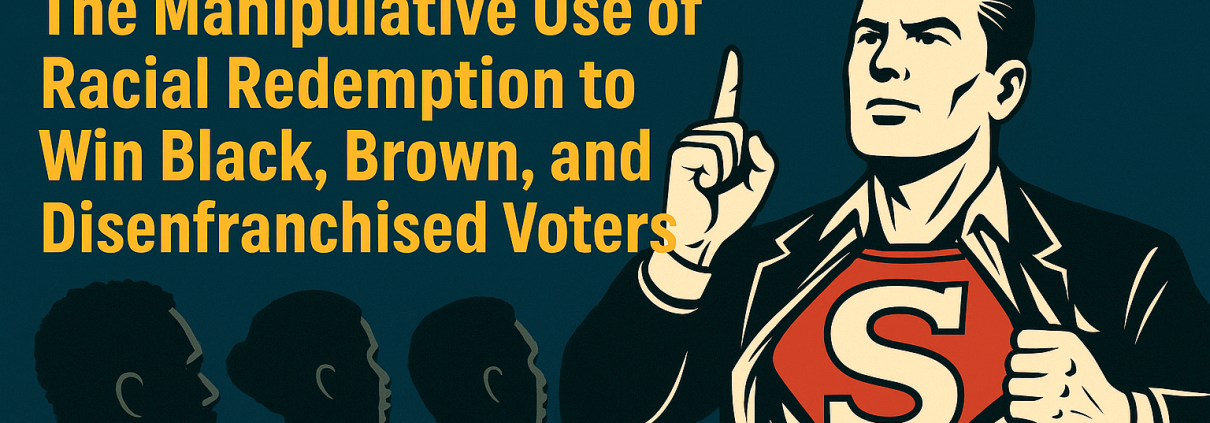Saviorism in Politics: The Manipulative Use of Racial Redemption to Win Black, Brown, and Disenfranchised Voters
By Anne Webster | Photo Copyright of IQ INC.
In American politics, a recurring strategy has been employed by many politicians—particularly white and often Democrat-leaning—who position themselves as “saviors” of marginalized communities. This phenomenon, known as political saviorism, relies on appealing to Black, Brown, and disenfranchised voters through promises of protection, social uplift, and justice, without delivering transformative change. Saviorism thrives on symbolic gestures, moral grandstanding, and identity optics while preserving systems of inequality that benefit the very elites making these appeals.
This article examines the roots, mechanics, and consequences of political saviorism, particularly within the Democratic Party, and its impact on voter trust, political efficacy, and racial justice movements in the United States.
The Historical Roots of Political Saviorism
Saviorism in American politics draws from older racial tropes that frame white figures—whether missionaries, abolitionists, or civil rights allies—as benevolent liberators of people of color. This legacy was institutionalized during the Reconstruction era, New Deal policies, and later the Civil Rights Act, often accompanied by white-led narratives of heroism. Though many of these measures were essential to progress, the framing consistently centered white leadership as the moral compass guiding non-white communities to freedom, rather than as collaborators in a shared struggle.
In modern electoral politics, this legacy survives through white candidates who campaign as guardians of minority rights, often using emotionally charged imagery, selective histories, and identity validation (such as quoting Martin Luther King Jr. or highlighting friendships with Black activists) to imply trustworthiness.
How Saviorism Works: Tactics and Messaging
- Performative Allyship Over Policy Substance
Politicians often express support for racial justice in abstract terms while avoiding confrontation with economic or institutional power. They may kneel in kente cloth, quote Malcolm X selectively, or join Black Lives Matter marches, yet oppose police budget cuts or resist reparations. - Emotional Leverage and Identity Politics
Saviorism capitalizes on trauma. By invoking slavery, segregation, or immigration raids, politicians portray themselves as empathetic protectors. While emotional resonance matters, it often masks the absence of concrete reform plans. Token appointments and racial “firsts” (e.g., the first Latina cabinet member, the first Black VP) are used to signal progress, though the systems remain unaltered. - Controlling the Narrative
The savior class presents itself as the only viable defense against Republican extremism. This “lesser evil” framing pressures marginalized voters to support status quo candidates out of fear rather than enthusiasm. It discourages independent political organizing and stifles critiques from within the community by painting them as self-destructive or disloyal. - Withholding and Dismissing Demands
When Black or Brown activists call for structural change—such as defunding the police, canceling student debt, or providing universal healthcare—they are often told to “wait,” that “now is not the time,” or that “America isn’t ready.” Such dismissals betray the transactional nature of saviorism: your vote is needed, but your needs are negotiable.
Case Study: Democratic Saviorism in National Elections
During the 2020 presidential election, Joe Biden’s campaign is a textbook example. He anchored his appeal on defeating Trump and restoring “the soul of America,” framing himself as the necessary protector of democracy and decency. He explicitly credited “Black voters” in South Carolina for “saving” his campaign, a phrase that implied mutual obligation. Yet, once elected, many of the central demands from these communities—such as voting rights protections, police reform, and student debt cancellation—were delayed, compromised, or abandoned.
Similarly, white progressive politicians who often speak passionately about injustice abroad or economic exploitation are sometimes slow to center racial justice at home, especially when it involves confronting their own party’s complicity in policing, housing segregation, or education inequality.
Saviorism as Political Gaslighting
Political saviorism is a form of gaslighting because it positions those seeking real change as ungrateful or unrealistic. When Black or Latino voters question establishment Democrats or advocate for third-party alternatives, they are told they are enabling fascism. This narrative guilt-trips vulnerable populations into voting defensively, rather than being empowered to demand better.
Saviorism also reinforces the myth of dependency—suggesting that Black and Brown communities need to be rescued rather than be trusted to lead themselves. This undermines grassroots movements and reinforces top-down models of change that favor elite control.
The Erosion of Trust and Voter Disillusionment
This dynamic helps explain growing voter apathy and political disillusionment. Many working-class Black and Brown Americans do not vote—not out of ignorance or laziness, but from a sense that no party truly represents their interests. Saviorism erodes political trust by making promises during election cycles and delivering little thereafter. The result is a cycle of cynicism, which paradoxically makes communities more vulnerable to exploitation in future elections.
Who Benefits?
Political saviorism benefits elites—white politicians, corporate donors, and media strategists—who maintain their power through symbolic representation. It also benefits party machines that use racial loyalty as a shield against internal accountability. Meanwhile, the very conditions that demand savior rhetoric—poverty, police violence, deportations, health disparities—remain largely unchanged.
Moving Beyond Saviorism: Toward Self-Determined Politics
To disrupt this cycle, Black, Brown, and disenfranchised voters must:
- Invest in local and independent candidates who come from their communities and are accountable to their needs.
- Demand policy-based campaigns with measurable commitments, timelines, and budgetary plans.
- Challenge the monopoly of the two-party system, creating space for third-party and grassroots alternatives.
- Support media and narratives that center community-led leadership, rather than savior tropes.
Conclusion
Saviorism is not just a political tactic—it is a form of psychological and cultural manipulation. While it offers comfort and reassurance, it robs marginalized communities of agency and reinforces structural dependency. For true progress to occur, voters must recognize saviorism for what it is: a trap disguised as solidarity. Only by rejecting symbolic politics in favor of real power-building can the disenfranchised reclaim their voice and future.




Leave a Reply
Want to join the discussion?Feel free to contribute!